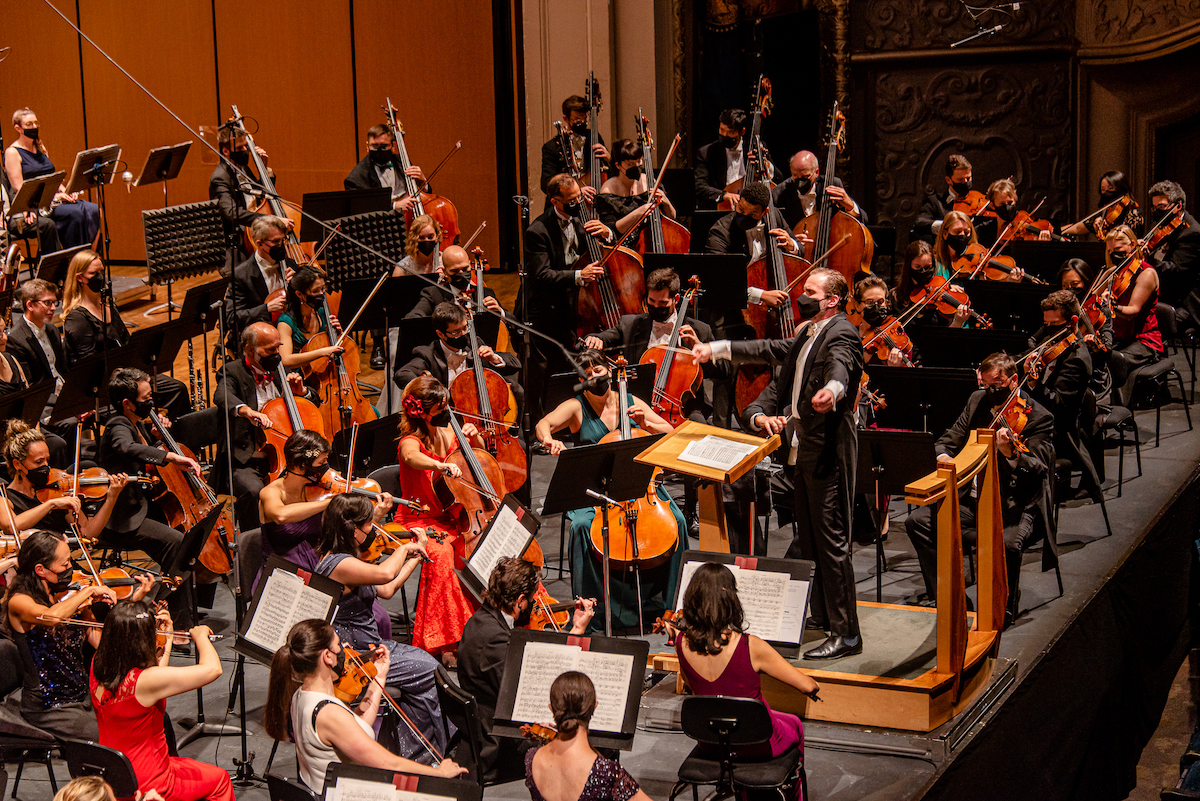As he took the stage before a crowded theater at the Oregon Symphony, acclaimed Austrian musical director David Danzmayr introduced the night’s performance to a masked audience. The feature of the night was Mahler’s Second Symphony, better known by its subtitle, “Resurrection.”
“We chose it tonight,” Danzymyr explained through the black fabric of his mask, “because for us, it is like a resurrection.”
With the Symphony’s doors opening after being shuttered for the last 18 months, it isn’t hard to follow Danzmayr’s sentiment. For the assembly onstage, it was the first time performing in the hall before a live audience in well over a year, and for the concert-goers in the audience, the performance represented a welcome return to live music for the first time since the pandemic began.
Despite the ongoing status of the pandemic—and fears of reduced vaccine effectiveness from the new Delta variant—love of the symphony brought throngs of classical music lovers into the symphony’s red-curtained halls; among them was Oregon Governor Kate Brown, whose presence gave the event a symbolic gravity. One patron, Scott Tell, observed the concert’s larger importance, describing the rituals of the reopening night as “almost like a ceremony of state.” Everywhere the air was charged with excitement, and at the intermission, concertgoers, young and old, enthusiastically talked about the symphony’s first three movements.
The night had its own theme, whispered in the auditorium and spoken under the marquee whenever someone said the concert’s informal name: resurrection. As the crowd flooded back into the auditorium after intermission to hear the symphony’s final two movements, they were washed with the sounds of Mahler’s chorus, sung in their original German lines. A translation of the lyrics tucked into the concert program captured the sentiment of the night perfectly, reading, “I died so that I may live.”
True to theme and posturing, the symphony has, in fact, improved on itself going into its self-professed rebirth. The 93-year-old building has been retrofitted with cutting-edge Meyer Constellation Acoustic Technology, bringing the nearly century-old auditorium solidly into the 21st century. If the hall had been filled with sound before the post-pandemic upgrade, it is practically overflowing with music now. With the new renovations, the string section of the concert’s first movement almost vibrates the seat rests, and the percussion’s already thunderous output is given teeth-rattling force.
In the onstage assembly, the difference was felt by the performers as well. “We are all just so happy to be back in the hall, with the new sound system,” said bassoonist Nicole Haywood, after the premiere. “It’s like we’re in a brand-new hall.”
Outside of a few practice concerts, the Saturday performance was one of the first times Haywood and her colleagues had experienced the sound of Mahler’s Second in the upgraded theater. “I think our artistic product is even better…I can’t believe we get to play Mahler three more times,” she said.
Besides the physical additions to the building, some of the people filling it with music are new as well. Austrian conductor David Danzamyr is joining the symphony this season as Music Director Chair, filling the space left behind by his predecessor, veteran conductor Carlos Kalmar.
Danzamyr grew up near the birthplace of Mozart and brings almost a lifetime’s worth of conducting experience to the Oregon Symphony, and his directorial debut of the 2021 season will be the first of many this year. In the coming months of the Fall season, the Symphony is scheduled to play a live-score rendition of The Nightmare Before Christmas, Tchaikovsky’s Piano Concerto No. 1, Legends of the Harlem Renaissance and more.
As much of a milestone as the symphony’s return to live music is, signs of the ongoing pandemic still cling to the venue’s operations. Under the marquee, greeters formed an ad-hoc vaccination enforcement team, ensuring that only vaccinated ticket holders passed through the ornate brass doors. In the theater itself, the crowd was actually even fuller than it appeared—hordes of patrons were viewing the event from the safety of their homes, a seating option that could hardly be imagined 18 months ago. Onstage, the performers themselves remained masked, and even the choir had to sing their heavy German lines through black cloth masks. Only the sopranos stood maskless in the sea of covered faces, performing for an equally well-protected crowd.
But by the end of the concert, as the shocking wave of Mahler’s fifth movement swept the auditorium, all these details faded into the background, leaving behind the simple fact of the music, which seemed to capture the age-old credo: the show must go on.
